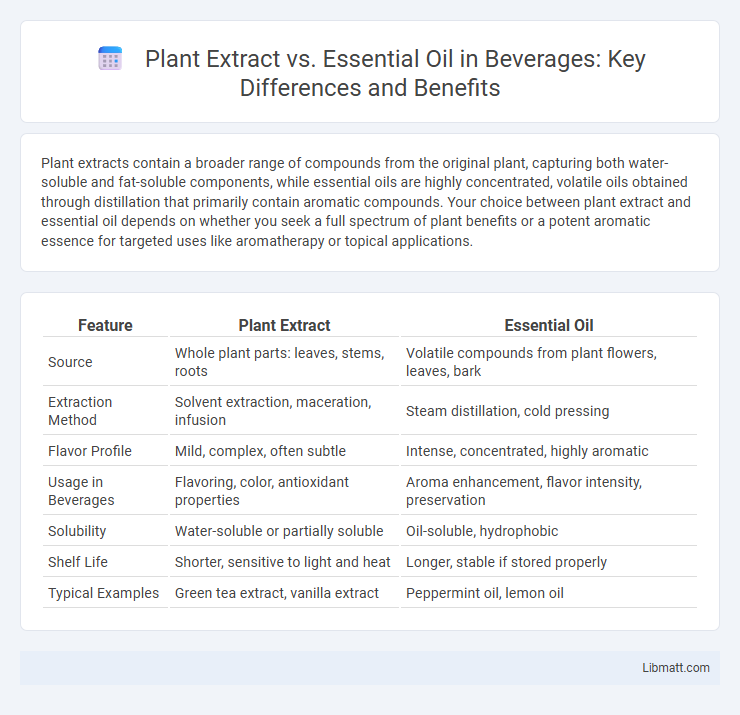Plant extracts contain a broader range of compounds from the original plant, capturing both water-soluble and fat-soluble components, while essential oils are highly concentrated, volatile oils obtained through distillation that primarily contain aromatic compounds. Your choice between plant extract and essential oil depends on whether you seek a full spectrum of plant benefits or a potent aromatic essence for targeted uses like aromatherapy or topical applications.
Table of Comparison
| Feature | Plant Extract | Essential Oil |
|---|---|---|
| Source | Whole plant parts: leaves, stems, roots | Volatile compounds from plant flowers, leaves, bark |
| Extraction Method | Solvent extraction, maceration, infusion | Steam distillation, cold pressing |
| Flavor Profile | Mild, complex, often subtle | Intense, concentrated, highly aromatic |
| Usage in Beverages | Flavoring, color, antioxidant properties | Aroma enhancement, flavor intensity, preservation |
| Solubility | Water-soluble or partially soluble | Oil-soluble, hydrophobic |
| Shelf Life | Shorter, sensitive to light and heat | Longer, stable if stored properly |
| Typical Examples | Green tea extract, vanilla extract | Peppermint oil, lemon oil |
Introduction to Plant Extracts and Essential Oils
Plant extracts are concentrated oils or liquids derived from various parts of plants, including leaves, roots, and flowers, through processes like solvent extraction or maceration, preserving a broad spectrum of the plant's bioactive compounds. Essential oils are highly potent volatile aromatic compounds extracted primarily via steam distillation or cold pressing, known for their strong fragrance and therapeutic properties. Understanding the differences between plant extracts and essential oils can help you select the most effective natural ingredient for applications in skincare, aromatherapy, or herbal medicine.
Extraction Methods: Comparing Techniques
Plant extracts are typically obtained using solvent extraction methods such as maceration, percolation, or infusion, which involve soaking plant material in liquids like ethanol or water to draw out bioactive compounds. Essential oils are extracted primarily through steam distillation or cold-pressing, techniques designed to capture the volatile aromatic compounds without altering their chemical composition. While solvent extraction yields a broad spectrum of phytochemicals including non-volatile substances, distillation focuses on isolating highly concentrated, volatile oils with distinct therapeutic and aromatic properties.
Chemical Composition Differences
Plant extracts contain a broader spectrum of bioactive compounds, including flavonoids, alkaloids, tannins, and glycosides, whereas essential oils primarily consist of volatile aromatic compounds such as terpenes, phenolics, and esters. The chemical composition of plant extracts is often more complex, with both polar and non-polar molecules depending on the extraction solvent, while essential oils are predominantly hydrophobic and distilled through steam or hydro-distillation. These compositional differences influence their respective therapeutic properties, stability, and applications in cosmetics, aromatherapy, and pharmaceuticals.
Aromatherapy and Therapeutic Uses
Plant extracts contain a broader range of bioactive compounds, making them effective for diverse therapeutic applications such as topical treatments and herbal remedies. Essential oils, highly concentrated and volatile, are specifically prized in aromatherapy for their potent fragrance and rapid absorption, promoting relaxation and mood enhancement. Your choice between plant extract and essential oil depends on whether you seek holistic healing properties or aromatic benefits for therapeutic use.
Applications in Skincare and Cosmetics
Plant extracts deliver targeted antioxidants and anti-inflammatory compounds essential for soothing irritated skin and promoting cellular regeneration in skincare formulations. Essential oils contribute potent antimicrobial and aromatic properties, enhancing product preservation and sensory appeal in cosmetics. Combining both ingredients optimizes efficacy by balancing therapeutic benefits with fragrance complexity in advanced skin treatments and beauty products.
Safety and Potential Side Effects
Plant extracts typically contain a broad range of compounds, making them generally safer and less concentrated than essential oils, which are highly potent and can cause skin irritation or allergic reactions if not properly diluted. You should always conduct a patch test before using essential oils and consult guidelines for safe topical or aromatic use to avoid adverse effects. Understanding the specific composition and recommended dosage of each product is crucial for minimizing risks and ensuring safe application.
Environmental Impact and Sustainability
Plant extracts typically have a lower environmental impact compared to essential oils due to their extraction methods, which often require less energy and raw plant material. Essential oil production involves high volumes of plant biomass and energy-intensive distillation, raising concerns about sustainability and biodiversity loss. Choosing sustainably sourced plant extracts and essential oils supports conservation efforts and reduces carbon footprints in aromatherapy and natural product industries.
Efficacy in Herbal Medicine
Plant extracts contain a broad spectrum of active compounds that provide comprehensive therapeutic effects, making them highly effective in herbal medicine for treating various ailments. Essential oils, concentrated volatile compounds distilled from plants, offer potent antibacterial, antifungal, and anti-inflammatory properties but may lack the full phytochemical diversity found in whole extracts. Your choice between plant extract and essential oil should depend on the specific health benefit desired and the method of application for optimal efficacy.
Cost and Accessibility Analysis
Plant extracts generally offer a more affordable option compared to essential oils, which often require intensive distillation processes that increase production costs. Their accessibility is higher since plant extracts can be derived using simpler methods and sourced in larger quantities, making them easier to obtain for everyday use. You can benefit from cost-effective plant extracts when seeking natural ingredients for wellness or skincare without sacrificing quality.
Choosing the Right Option for Your Needs
Plant extracts contain a broad range of bioactive compounds obtained through processes like solvent extraction, resulting in a complex mixture with therapeutic and nutritional benefits. Essential oils are concentrated aromatic compounds extracted by steam distillation or cold pressing, offering potent effects ideal for aromatherapy and topical applications. Choosing the right option depends on your specific needs, whether you seek the holistic properties of plant extracts or the intense, targeted benefits of essential oils.
Plant extract vs essential oil Infographic

 libmatt.com
libmatt.com